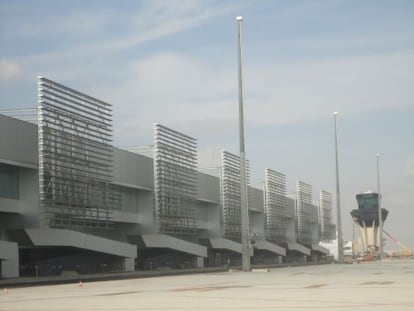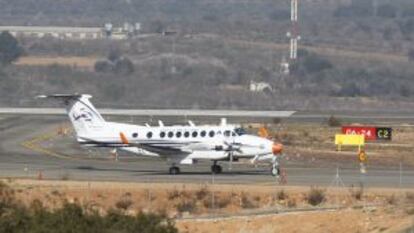Corvera, the smart new kid on the block in Spain's empty airports club
Murcia government pressed ahead despite improvements to existing strip

Antonio Sánchez Hernández expresses the irrefutable logic of the countryside. "I suspect they'll open it so that they can close it later," he says, pointing at the signs that proclaim "International Airport of the Murcia Region." Antonio, 72, a retired marble cutter and a farmworker in his spare time, sprinkles water on the earth in an attempt to save his modest harvest.
The airport he is pointing to across the motorway is a gray building, covered with stainless steel panels. It's an attractive building and is said to have won design awards. Entry is forbidden - all you can see is the scrubland between the runway, the empty parking lot and the unused control tower. Not a single commercial flight has landed here, despite the fact that the airport, which cost 266 million euros, was finished a year ago. To the shameful list of Spanish airports without planes - Castellón, Ciudad Real and Huesca - we can now add Corvera, which is yet to be inaugurated.
Murcia was going to be Florida - or rather, California. During the boom years, thousands of new apartments and golf courses were built, all located near the coast to attract the British. The regional government joined the party. Money appeared to be no object. That attitude led to building of the Cartagena-Vera toll road, which covers 100 kilometers of near-virgin coastland, and was designed to service these future resorts.
Then came the plan to build Marina de Cope, a mega-complex located in a natural park. The sweetener on the top of the plan was a private airport, designed to attract crowds of tourists. For the Popular Party (PP) regional premier, Ramón Luis Valcárcel, the major Alicante airport, located just 75 kilometers from Murcia, was not sufficient. Nor was the partial use of the San Javier military base, which is actually located in Murcia.
If it were to open, it would need an immediate injection of public funds"
That was why, in 2006, he awarded the construction of the airport to a consortium led by construction company Sacyr. But in 2008, when the building work began, the problems started - nothing went to plan. "That was when the bank financing fell through and the franchise holder ran into difficulties," explains the general director of transport, Antonio Sánchez-Solís. "The negotiations with the banks hit a dead end, and so of course the regional government provided guarantees for the consortium. But that doesn't mean that they have forked out a single penny," he says.
That deal took the form of a 200-million-euro guarantee. The PP introduced it as an amendment to its 2010 budget and as such, tied its fate to the project. If the franchise holder were to go bankrupt, the creditor banks - Caixabanc, Espírito Santo, Caixa de Tarragona, Caja Segovia, Cajasol, the Official Credit Institute (ICO) and the Caja de Tarragona - would demand 200 million euros from an indebted region. In fact, in 2012 Murcia had to request bailout funds of 527 million euros from the Regional Liquidity Fund. "That was the moment when they should have dropped the project, and nothing would have happened," explains a source with knowledge of the plan, who agreed to speak on the condition of anonymity. "But Valcárcel was determined to press on."
With the guarantee from the region, credit began to flow and the pace of the construction work picked up. The project was finished a year ago, according to sources, but there was no ribbon-cutting nor champagne. The well-publicized disasters of Castellón and Ciudad Real have cast a long shadow over Murcia. No politician will be inaugurating another airport without planes. "It is still in the fitting phase and a few authorizations are pending," says the regional head of transport, who cannot confirm the date of its opening. "It would be rash to do so," he says. But a quick check of the newspaper archives reveals a number of missed deadlines already.
The main problem lies with the fact that, 35 kilometers away, the Public Works Ministry has just invested 70 million euros in improvements to the San Javier airport. Spanish airports authority AENA, which was in charge of managing the civil side of the project, built a new terminal there between 2004 and 2011, as well as another runway and a control tower. And it is calling on the region or the new airport to pick up the bill. "Neither the region nor the franchise holder have that money," explains a source from the project. "What they can do is transfer those assets to the Defense Ministry."
Out of the blue... a plane

The news of an airport without planes made headlines around the world, with the infamous project in Castellón becoming the perfect example of the wasteful spending of the regional and provincial governments during the construction boom in Spain. But Castellón airport finally saw its first plane land last Monday - albeit a test plane belonging to the AENA airports authority.
"It's not the only one, but it is an important milestone in the long certification process that is still to be completed," said the director of the public company Aeropuerto de Castellón SL (Aerocas), Juan García Salas, in reference to the test flights by light aircraft that are being used to certify the airport's navigation systems and its infrastructure. The flights come nearly two years after the initial fanfare of the airport's inauguration, despite it not having the certification in place for planes to land there, nor indeed a sufficiently long runway for proper use.
Mistakes like the latter have meant that the administrative process has taken 24 months to get this far, when in fact it should have taken just six.
It's a venomous situation: a new airport that cost 266 million euros is calling for another airport, a public one, which is located 35 kilometers away and in which 70 million euros have been invested, to close down. "Valcárcel was determined to have his airport when he knew that AENA was investing in San Javier. He said that it would triple the arrival of tourists, but there's been no change," says Socialist spokeswoman Begoña García Retegui.
Despite the region's assurances that everything is in order, and that there is no risk with regard to the guarantee, the months slip by and the shareholders are getting nervous. Aside from Sacyr, other investors include banks such as CAM and Caja Murcia, and real estate firms Montoro e Hijos and Inprisma. Each one has a stake of around 6 percent, but several are getting tired of paying interest without a fixed inauguration date. Montoro e Hijos has already asked for a way out, according to the company.
Even if AENA agrees to close the San Javier airport, there would still be storm clouds over the project. The numbers cited when the project was created look very suspect. Passenger traffic at San Javier has fallen from two million in 2007 to 1.2 million in 2012. If Corvera were to absorb all of San Javier's traffic, it still wouldn't reach 5.2 million passengers in 2015, as the contract stipulated. "If it were to open, it would need immediate injections of public funds, as has been done with the toll roads," explains a source with knowledge of the operation. The franchise holder has declined to comment on the situation, although it has been pointed out that a renegotiation of such a deal is a regular practice.
Away from the negotiations between Sacyr, AENA and the region, the locals are equally disappointed with the project. The owners of the expropriated land where the construction took place have only received a part of the money they were promised. Ascensión Noguera is among the 90 people who have been affected by this. "I am paying a mortgage for a lemon orchard that I bought with great excitement, and now I've been left with nothing."
Antonio Sánchez, the farmer, offers his opinion: "There's not a single penny left. The money has gone. In that golf resort there are 1,500 houses, with 20 families living there. The foreigners are sick of being conned." He smiles as he speaks, but each sentence he utters is like a hammer blow. "The airport wasn't needed, but they have all made mistakes: the politicians and the banks. What we should have taken 30 years to do, we did in 10, and now someone has to pay for it all."
Tu suscripción se está usando en otro dispositivo
¿Quieres añadir otro usuario a tu suscripción?
Si continúas leyendo en este dispositivo, no se podrá leer en el otro.
FlechaTu suscripción se está usando en otro dispositivo y solo puedes acceder a EL PAÍS desde un dispositivo a la vez.
Si quieres compartir tu cuenta, cambia tu suscripción a la modalidad Premium, así podrás añadir otro usuario. Cada uno accederá con su propia cuenta de email, lo que os permitirá personalizar vuestra experiencia en EL PAÍS.
¿Tienes una suscripción de empresa? Accede aquí para contratar más cuentas.
En el caso de no saber quién está usando tu cuenta, te recomendamos cambiar tu contraseña aquí.
Si decides continuar compartiendo tu cuenta, este mensaje se mostrará en tu dispositivo y en el de la otra persona que está usando tu cuenta de forma indefinida, afectando a tu experiencia de lectura. Puedes consultar aquí los términos y condiciones de la suscripción digital.
Últimas noticias
UN team enters Sudanese city of El Fasher after paramilitary massacre: ‘It’s like a ghost town’
A recipe for resistance: Indigenous peoples politicize their struggles from the kitchen
Grief and unanswered questions surround Swiss ski resort of Crans-Montana after fire that left 40 dead
Dead tired: The things that ruin women’s sleep
Most viewed
- Gilles Lipovetsky: ‘If you want to live better and fall in love, take Prozac, don’t look to philosophy’
- Alain Aspect, Nobel laureate in physics: ‘Einstein was so smart that he would have had to recognize quantum entanglement’
- Maduro’s downfall puts China’s relationship with Venezuela to the test
- Why oil has been at the center of Venezuela-US conflicts for decades
- Oil, gold and rare earth elements: the backdrop to US political tension with Venezuela








































